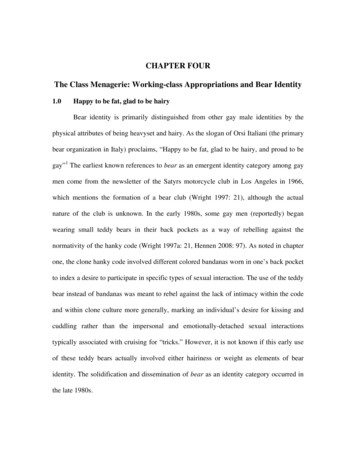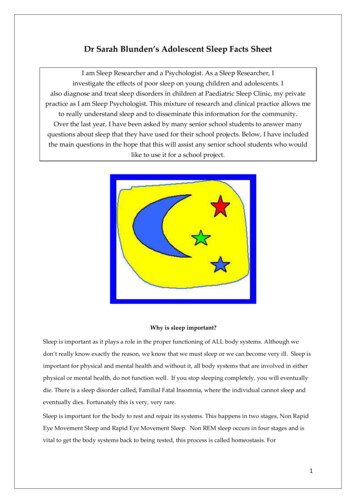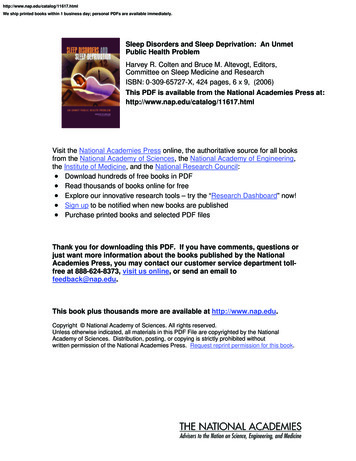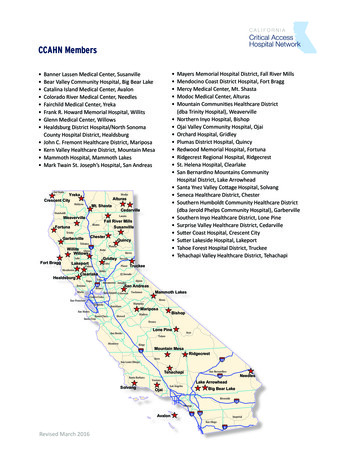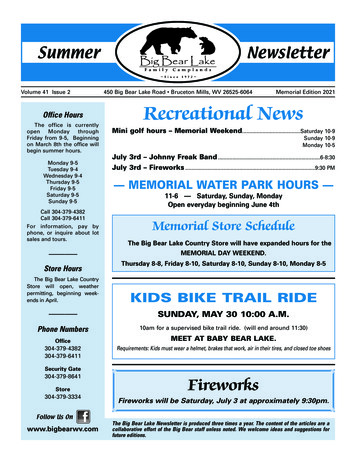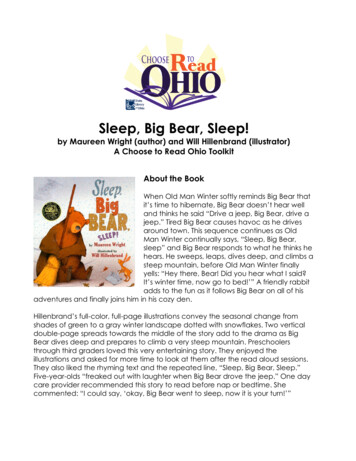
Transcription
Sleep, Big Bear, Sleep!by Maureen Wright (author) and Will Hillenbrand (illustrator)A Choose to Read Ohio ToolkitAbout the BookWhen Old Man Winter softly reminds Big Bear thatit’s time to hibernate, Big Bear doesn’t hear welland thinks he said “Drive a jeep, Big Bear, drive ajeep.” Tired Big Bear causes havoc as he drivesaround town. This sequence continues as OldMan Winter continually says, “Sleep, Big Bear,sleep” and Big Bear responds to what he thinks hehears. He sweeps, leaps, dives deep, and climbs asteep mountain, before Old Man Winter finallyyells: “Hey there, Bear! Did you hear what I said?It’s winter time, now go to bed!’” A friendly rabbitadds to the fun as it follows Big Bear on all of hisadventures and finally joins him in his cozy den.Hillenbrand’s full-color, full-page illustrations convey the seasonal change fromshades of green to a gray winter landscape dotted with snowflakes. Two verticaldouble-page spreads towards the middle of the story add to the drama as BigBear dives deep and prepares to climb a very steep mountain. Preschoolersthrough third graders loved this very entertaining story. They enjoyed theillustrations and asked for more time to look at them after the read aloud sessions.They also liked the rhyming text and the repeated line, “Sleep, Big Bear, Sleep.”Five-year-olds “freaked out with laughter when Big Bear drove the jeep.” One daycare provider recommended this story to read before nap or bedtime. Shecommented: “I could say, ‘okay, Big Bear went to sleep, now it is your turn!’”
http://oh.webjunction.org/ohctrointroOne kindergarten teacher appreciated that the book made the children think, asit stirred up many questions. First graders enjoyed how Big Bear keptmisunderstanding, and they tried to guess what he would do next based onpicture clues. One second grade teacher shared that her class loved the bookand that the story led to a good discussion on confusing what people say. And, ofcourse, the children wanted the book read over and over.Permission to use book jacket image and book description granted by Will Hillenbrand.Book DetailsSleep, Big Bear, Sleep written by Maureen Wright, illustrated by Will HillenbrandMarshall Cavendish Corporation, 2009, 978-0-7614-5560-8. Ages 4-8.http://www.marshallcavendish.us/kidsSleep, Big Bear, Sleep! Is a Wanda Gág Book Award 2010 ks2010.cfm#SleepBigBearSleepAbout the AuthorMaureen Wright and her husband, Don, have three sonsand a daughter-in-law. One high school-age son still livesat home. The author lives in the country in AthensTownship, Pennsylvania, where bears occasionally crosstheir property. She has written many stories about bears,finding their comical natures suited to children's stories.She is aware of the dangers, though! Two of her sonsonce had to climb a tree in the woods to avoid a passingbear!Maureen enjoys writing in rhyming verse because herfavorite books to read to her boys when they were youngwere lyrical. She decided to try her hand at picturebooks after babysitting a one-year-old and having the baby crawl away while Maureensat there happily reading a rhyming verse book and laughing out loud. She writes athome with her old dog, Sandy, and cat, Lyle, by her side.Photograph and biographical information courtesy Maureen Wright; used with permission.Author Resources:Maureen Wright’s official websitehttp://booksbymaureenwright.com/For publicity and speaking engagement om-presentations/
http://oh.webjunction.org/ohctrointroAbout the IllustratorI have lived almost all my life in Cincinnati, Ohio,where I grew up surrounded by stories. My parentsowned a barber shop where I listened toconversations that seemed to me stories about adultlife. When I wasn't at the shop, I spent hours atbaseball games, sharing the stories about the teamsand players. My grandmother, who lived nearby,shared stories about her earlier life on a farm with mythree brothers and me when we kept her companyduring thunderstorms.Drawing was how I captured the stories I heard. Myolder brother sketched cartoons and I began by copying him. I drew mostly at thekitchen table, but also used my crayons on stairwell walls. My early pictures stilldecorate the basement of my mother's house.My first art class came when I was a sophomore in high school. I was sure everyoneelse was more talented and experienced, but I discovered that all those years oflistening and drawing had given me a good idea for putting ideas together aspictures. I went on to art school, although my father was worried that I wouldn't beable to make a living. When I graduated, I found work in advertising, but after aclass in picture book art, I decided to try my hand at illustrating children's literature.Now it is my full-time work. I spend a lot of time in schools sharing my picture booksand how I create them. I think it's important for children to enjoy the process of artand not worry too much about the finished product.When I approach a story, I think of myself as a choreographer adding movementto a score or a movie director bringing a script to life. I read the story many times,just to let the wonder of it wash over me and feel it stretch and deepen in myimagination. I really work in three worlds at once: the world of the imagination, theworld of myth, and the physical world; children seem to live comfortably in allthree. Successful illustrations link these worlds together and give a visual voice tothe story.As I begin to draw, I try to keep the child's viewpoint foremost in my mind. For eachbook, I keep a journal of my sketches. Every journal has a child's drawing tuckedinside to remind me that a child's imagination is the starting and ending point formy art. My studio shelves are lined with marionettes, stuffed toys, and folk artanimals to help me with ideas for my drawings. My wife, Jane, and our son, Ian,provide inspiration, too.Biography and photograph courtesy Will Hillenbrand; used with permission.
http://oh.webjunction.org/ohctrointroIllustrator Resources:Will Hillenbrand’s Official Websitehttp://willhillenbrand.com/For publicity and speaking engagement inquiries:Tish Gayle, Literary Events Agent808 Lexington Ave. Terrace Park, Ohio 45174E-mail: tish@willhillenbrand.comAwards Will Hillenbrand has won Starred review from Publishers Weekly for Counting CrocodilesHorn Book Fanfare List 1997 for Coyote and the Fire StickIRA Children’s Choice Award for Sam Sunday and the Mystery at the OceanBeach HotelIRA Children’s Choice Award for The House that Drac BuiltIrma S. and James H. Black Bank Street College of Education Award forexcellence in text and illustration, Bulletin of the Center for Children’s Books1995 Blue Ribbon Book, and School Library Journal Best Books of 1995 forWicked JackALA Notable Book Award for Traveling to TondoGold Medal and honors from the Society of IllustratorsWill Hillenbrand’s artWill Hillenbrand shares his processes for creating the illustrations for his books. Thereare a number of great resources for learning about how Will creates his art h page has activities called "You Try It!" so that the steps Will takes can bereplicated by kids.
http://oh.webjunction.org/ohctrointroTalk About It!Topics to share when discussing this book with children It is time for Big Bear to hibernate. Talk about hibernation, what it is, whodoes it, when do they do it, and why. Rhyming words are used in this story. Say the words out loud together.What same sound is in all of the rhyming words? Big Bear does many things in this story like drive a jeep and dive downdeep. Which of those things can a bear really do? Which of those thingscan people do? Part of Big Bear’s trouble is that he doesn’t hear so well. Is he being agood listener? Talk about listening and why it is important. At the beginning of the story, Old Man Winter whispers softly to Big Bear,but by the end he is shouting. Encourage listeners to say with you, “sleep,Big Bear sleep!” as you read the story, getting a little louder each time.Talk about softer and louder sounds, and why Old Man Winter might beshouting by the end of the story. At the end of the story Big Bear puts on his pajamas, fluffs his pillow andhugs his teddy as he gets ready to go to sleep. What are some otherthings people might do when they get ready for bedtime? Bear has an animal friend with him on each page of the book. Whatanimal is it? Have listeners find and name other animals on the pages ofthe book. This story is about the coming of winter. In what ways can we tell that byreading this story?Many of the ideas listed above incorporate the six early literacy skills that help childrenget ready to read. Recognizing letters (Letter Knowledge) and understanding that theymake sounds that form words (Phonological Awareness). Knowing that things havenames and being able to name them (Vocabulary). Telling a story or describing eventsthat happened in a story (Narrative Skills). Noticing and recognizing text (PrintAwareness), and the interest in and enjoyment of books (Print Motivation). All of thesethings lead to children being ready to learn how to read when they begin school.For more information: http://www.ohreadytoread.org/.
http://oh.webjunction.org/ohctrointroLearn and have fun!Here are some fun ideas for extending the story Have a picnic inside or outHave a snack that includes honeySet up a campsite with a tent (a blanket and a table work fine!)Go on a “bear hunt”Sing The Bear Went Over the MountainPlay leapfrogMake a jeep from a large cardboard box that children can “drive”Role-play some of the activities in the story, driving, sweeping, leaping.Play King of the Mountain (or a friendly version of!) if there is a hill nearby,or use a piece of playground equipment.Fun storytimes to associate with Sleep, Big Bear, Sleep might include BearsAnimalsAnimal sTransportation/Things that goTake a trip! Visit a zooSchedule a visit from a beekeeper or possibly visit one.Plan a visit to a lake or pond. Talk about the animals that live in the water.Go swimming! If possible schedule a swimming trip to a nearby pool orlake. An inflatable pool would also work!
http://oh.webjunction.org/ohctrointroTie It In!Using this book with the Ohio Pre-Kindergarten Content StandardsThe Ohio Department of Education adopted revised Pre-Kindergarten Content Standards in2011. These standards describe what young learners should know and be able to do in Englishlanguage arts, mathematics, science and social studies before entering kindergarten. Earlychildhood educators are implementing these standards in their schools and centers. For moreinformation, including the complete set of standards, follow this link to the Ohio Department ofEducation site: http://bit.ly/tBOl0P.Every Choose to Read Ohio book for young children may be used to support the English andLanguage Arts Reading Standards for Literature and Reading Standards: Foundational Skills.Here are examples of activities using Sleep, Big Bear, Sleep! that align with Pre-K standards.English Language Arts Reading Standards: Foundational Skills: Phonological awareness – Have childrenidentify the rhyming words that appear on each page (e.g. park, dark, well, dell,sleep, leap, etc.) and produce additional rhyming words.Reading Standards for Literature: Craft and Structure – Discuss what the author(Maureen Wright) and illustrator (Will Hillenbrand) contributed in presenting the ideasin Sleep Big Bear, Sleep! This book has a wonderful visual element to it that canreally be emphasized in a classroom setting.Mathematics Counting and Cardinality – use the illustrations to count. How many animals,people, trees are on the page? Point as you count.Science Life Science: Observations of Living Things – learn about bears and other animalsthat hibernate. What are their behaviors? Why do they hibernate?Social Studies History Strand: Words associated with time are meaningful in the context of dailyclassroom routines – discuss the order of events that occurred before Big Bear wentto sleep.Other Pre-Kindergarten Content Standards may also apply. See the Ohio Departmentof Education website (http://education.ohio.gov) for further information.
http://oh.webjunction.org/ohctrointroExplore More!Literacy resources for young children:This website for the Carnegie Library of Pittsburgh has many early literacyresources including ideas for Sleep, Big Bear, s/Hibernation2.htmlOhio Ready to Read, the early literacy initiative developed by the Ohio LibraryCouncil’s Children’s Services Division and the State Library of Ohio, has manygreat resources for librarians, educators and parents on teaching early literacyskills.http://ohreadytoread.org/National Association for the Education of Young Childrenhttp://www.naeyc.org/Association for Library Service to ex.cfmAbout Choose to Read OhioChoose to Read Ohio (CTRO) spotlights Ohio authors and promotes reading across Ohio. TheState Library of Ohio, in partnership with Ohioana Library Association, developed this initiative toencourage Ohioans of all ages to share literature by authors native to, residing in, or associatedwith Ohio. CTRO is adaptable for use in classrooms, libraries, bookstores, by book discussiongroups, families, and other community groups.Explore Choose to Read Ohio resources & toolkits: http://oh.webjunction.org/ohctrointro.This toolkit revised December 2011.
Sleep, Big Bear, Sleep! by Maureen Wright (author) and Will Hillenbrand (illustrator) A Choose to Read Ohio Toolkit About the Book When Old Man Winter softly reminds Big Bear that it's time to hibernate, Big Bear doesn't hear well and thinks he said "Drive a jeep, Big Bear, drive a jeep." Tired Big Bear causes havoc as he drives around .
